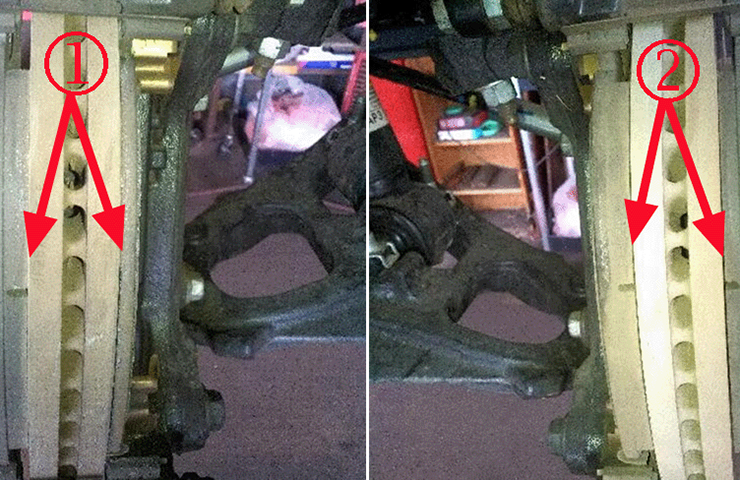Some 2014-2018 Silverado 1500, Sierra 1500; 2015-2019 Escalade, Tahoe, Suburban, Yukon; and 2019 Silverado LD and Sierra Limited models may have a brake pulsation or a grinding sound coming from the brakes. During an inspection, uneven front brake pad wear may be found.
Typically, vehicles with these conditions have low mileage, approximately 10,000 miles (16,000 km), and the inner pad on either the front-left side or front-right side has extremely biased wear.
Uneven brake pad wear consists of the following:
- Inboard to outboard brake pad wear difference of 3 mm (0.118 in.) or greater for ‘normal’ highway driving with no heavy loads, without trailer towing, and without frequent elevation changes
- Inboard to outboard brake pad wear difference of 6 mm (0.236 in.) or greater for heavy city driving, frequent elevation changes, frequent trailer towing, and heavy loads
- Left-to-right inboard to inboard or left-to-right outboard to outboard brake pad wear difference of 3 mm (0.118 in.) or greater for either driving condition
For example, uneven pad wear may involve a completely worn inner pad while the outer pad still had plenty of pad life (Fig. 13, #1) on one side of the axle while the brake pads on the opposite side may both have plenty of pad material left. (Fig. 13, #2)
 Fig. 13
Fig. 13
TIP: The disc brake pads should only be replaced if the friction surface is worn to within 2.0 mm (0.079 in.) of the mounting plates.
Brake System Inspection Tips
- Do not use any air tools to remove or install the brake caliper bolts. Use hand tools only.
- Install an open-end wrench to hold the caliper guide pin in-line with the brake caliper while removing or installing the brake caliper bolt. Don’t allow the open-end wrench to come in contact with the brake caliper.
- When compressing the caliper pistons, use large C-clamps over the top of the caliper housing and against the back of the outboard pad. Slowly tighten the C-clamps until the pistons are pushed completely into the caliper bores. Using this method will help determine if there is anything binding.
- Inspect and measure the brake pads thickness. Determine the type of driving the owner does and compare the measurements to the information for normal or heavy driving (3mm or 6mm).
If the pads are within specification, perform a normal brake repair. If the pads are out of specification, perform diagnostics according to the appropriate Service Information to determine the cause of the concern (caliper piston binding, binding pads or guide pins in bracket, brake hose restriction, etc.)
- If the cause for the uneven pad wear is not found, replace the front brake pads with the part number listed in Bulletin #19-NA-116. If the brake rotors require service due to excessive heat checking/blueing, it is recommended to replace the rotors rather than attempting to refinish them. Refer to the parts catalog for the correct Ferritic Nitro-Carburizing (FNC) rotors.
- After repairs and pad burnishing have been completed, test drive the vehicle for 20–30 miles (32–48 km) on an open road at cruising speeds of 55+ mph (88.5+ km/h) where very little braking is actually performed.
- Immediately after returning from the test drive, lift the vehicle on a hoist and spin both front wheels by hand. If a wheel is hard to spin, it may be an indication of a brake drag.
- With the condition present, perform diagnostics to determine the cause of the drag (caliper piston binding, binding pads or pins in the bracket, brake hose restriction, etc.). Repair if necessary and re-evaluate the vehicle.
For additional information, refer to Bulletin #19-NA-116.
– Thanks to Bob Hartman and Hassan Abdallah


















